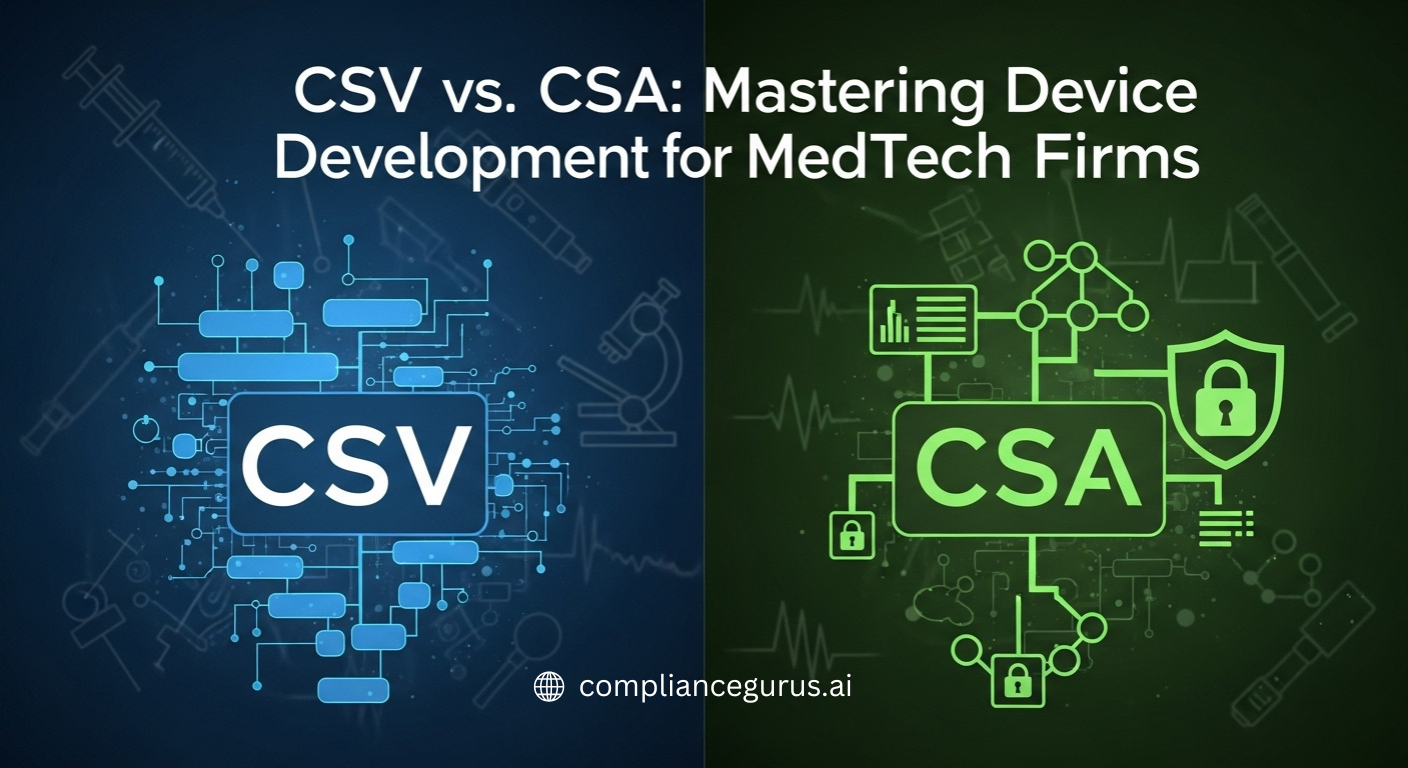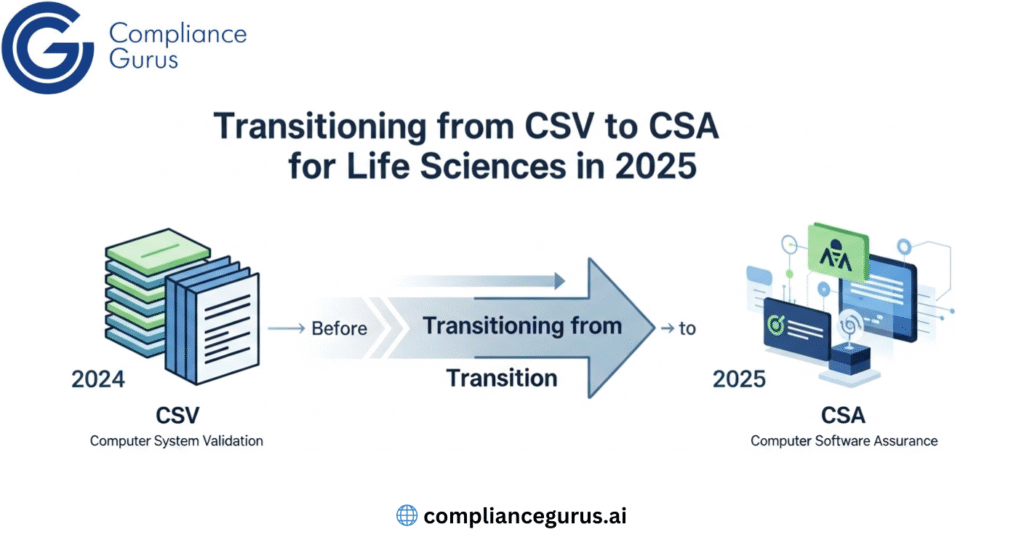In MedTech, real progress comes when you simplify the process without losing focus on patient safety and product quality.
In the world of medical technology, everything changes quickly. New devices, evolving software, and stricter rules can make the development process challenging. For MedTech companies, understanding the shift from traditional Computer System Validation (CSV) to the FDA-backed Computer Software Assurance (CSA) is now a must.
Knowing how each approach works will help you keep your devices safe, compliant, and ready for market – while also giving your team more time to focus on innovation. This guide explains CSV vs. CSA for medical devices in clear terms, so you can decide how to move forward with more confidence.
Why is Validation at the Heart of MedTech?
No medical device company can ignore compliance. If software controls a life-support device, manages patient data, or ensures dosage accuracy, it needs to work exactly as intended. That is where validation plays such an important role. It proves the system is safe, accurate, and in line with strict regulations.
The main challenge is making sure your validation process protects quality without creating unnecessary layers of paperwork. This is where understanding the difference between CSA and CSV becomes really important for every MedTech firm.
What is Computer System Validation (CSV)?
For years, CSV has been the standard for MedTech companies. It means proving through detailed documents and strict testing that your software works correctly and meets all regulations. It covers every corner of your system, no matter how critical or low-risk that part may be.
Key Points about CSV:
- Relies heavily on documentation for every step of the process
- Covers all system functions with equal testing effort
- Demands large amounts of time, effort, and team resources
- Focuses on complete CSV audit readiness to pass FDA and regulatory inspections
- Best suited for legacy systems and strict compliance environments
What is Computer Software Assurance (CSA)?
CSA is an updated way to achieve assurance that focuses on real risks instead of treating all features the same way. It is supported by the FDA and designed to help companies use smarter, more flexible validation.
The idea is simple – test more where risks are high and avoid wasting time on low-risk features that don’t impact patient safety, data integrity, or product quality.
Key Points about CSA:
- Keeps documents simple and clear without repeating steps unnecessarily
- Uses risk-based testing so high-risk areas get more attention and low-risk areas get just enough
- Supports cloud-based software assurance, AI tools, and automation
- Reduces cost and speeds up updates or software releases
- Matches modern agile methods for quicker improvements
CSV and CSA Compared in Simple Terms
CSV is like a full inspection of every room in a building, every single time you unlock the door. CSA is like focusing on the rooms that matter most and checking the rest as needed.
CSV is detailed and often slow, but has been the safe approach for years. CSA is targeted, faster, and still gives the proof that regulators expect. CSV is best when systems are old or the environment leaves no room for flexibility. CSA is ideal for modern, evolving systems where innovation matters.
Both keep patient safety and compliance as the top priority – they just have different ways of getting there.
Why is the FDA Pushing CSA Forward?
The FDA saw what was happening. Many companies delayed adopting new tools or software updates simply because the validation workload was too heavy. That meant patients were missing out on better technology.
By promoting CSA, the FDA encourages smarter validation without cutting corners. The focus shifts from “test everything the same way” to “test smarter and deeper where it matters.” This shift gives MedTech companies a better chance to innovate while keeping patient safety and compliance strong.
How CSA Works during Device Development?
Here is a clear look at how CSA can be applied when developing medical devices:
- Start with a Risk Assessment – Identify which features can directly affect patient safety, product quality, or data integrity.
- Use Vendor Support – Apply manufacturer or supplier test results where possible to avoid doing the same work twice.
- Match Testing Effort to Risk – Scripted tests for high-risk areas, lighter checks for low-risk areas.
- Monitor Continuously – Keep tracking performance as the product is used.
- Make Faster Updates – Add new features or fix bugs without going through unnecessary full-system validations.
- CSA works like a map for your compliance journey – showing you where to go deep and where to move faster.
Staying Ready for Audits
One question many teams ask is if CSA makes them less ready for an audit. The answer is no. CSA simply changes how documentation is done. Instead of shelves full of repetitive paperwork, you have focused and relevant evidence that shows the system is safe, effective, and compliant.
The idea is to make it easier for auditors to see exactly how you’ve managed risks and tested the most important features.
The Role of FDA Remediation
Even with the best approach, issues can still appear. That is why FDA remediation is essential for any MedTech company. If the FDA raises a concern through a 483, Warning Letter, or another notice, you need to act quickly and strategically.
A strong remediation plan includes:
- Finding exactly where compliance gaps exist
- Prioritizing fixes based on real risks instead of generic policies
- Addressing each FDA concern with specific actions
- Keeping proof that corrections have worked and will last
- Restoring trust with regulators and end users
FDA remediation is not just about fixing a problem, it’s about doing it in a way that strengthens your future compliance.
Why Cloud-Based Assurance Matters?
Today, many MedTech companies use cloud systems to manage data, automate testing, or integrate devices. This shift brings speed and flexibility, but also requires strong ongoing controls.
Cloud-based software assurance helps keep these systems safe, secure, and compliant. CSA is especially helpful here because it makes switching to, or maintaining, a cloud setup smoother while ensuring that quality and security standards stay high.
Examples of Success
Leading MedTech companies have proven the value of smart validation.
- One global pharma firm used CSA to cut validation time dramatically while improving compliance.
- Another optimized CSV practice for a legacy ERP system, passing audits with zero findings.
- A major biotech reduced cost and testing cycles by focusing assurance where it mattered most.
These examples show that both CSV and Computer Software Assurance can be powerful tools when used in the right situations.
Final Takeaway
Mastering CSV vs. CSA for medical devices is about more than just meeting rules. It’s about building a development process that protects patients, keeps you ready for audits, makes FDA remediation faster, and allows you to use modern tools like cloud-based software assurance.
When done right, the process doesn’t slow innovation – it supports it. The best path is one that fits your systems, your risks, and your goals, while keeping regulations in check and quality at its highest.
Strong assurance creates strong devices – and strong devices save lives.
Ready to Take the Next Step?
If you want to achieve strong CSV audit readiness, explore a CSA approach, or prepare for an easier FDA remediation process, our experts at Compliance Gurus can guide you through every step. With deep experience in MedTech compliance, we help you make the move from complicated to clear and from slow to fast, without losing what matters most – safety and quality.
Let’s connect and make your device development smarter, stronger, and ready for the future.








